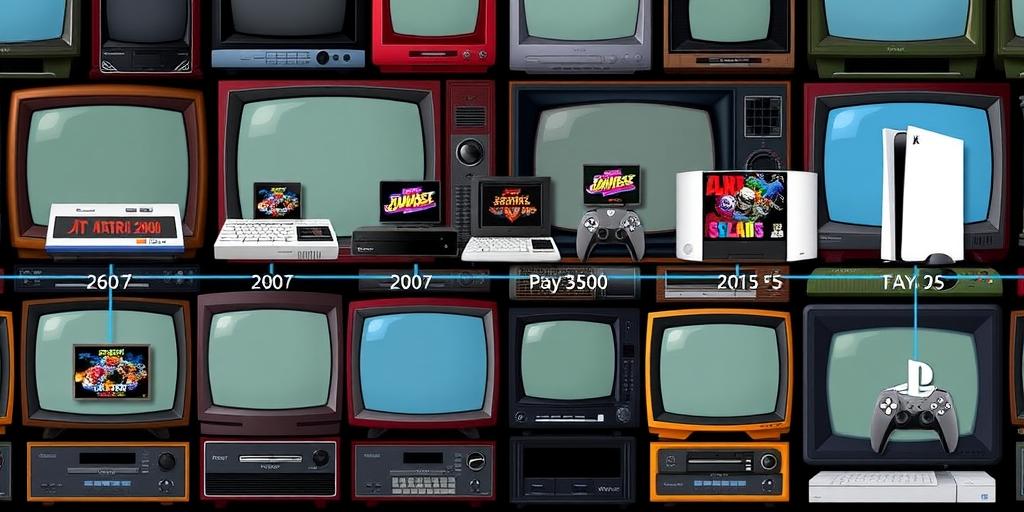From the pixelated graphics of the early days to the stunning visuals and immersive gameplay of today, gaming consoles have come a long way. This journey is filled with innovation, competition, and countless hours of entertainment. Let’s take a trip down memory lane and explore the evolution of these remarkable devices that have shaped the gaming landscape.
The Dawn of Console Gaming
The roots of console gaming can be traced back to the 1970s, with the emergence of early pioneers that laid the foundation for a future filled with interactive entertainment.
The Magnavox Odyssey: A Pioneering Effort
The Magnavox Odyssey, released in 1972, is widely considered the first home video game console. While its graphics were rudimentary, featuring simple black and white shapes on a television screen, the Odyssey introduced the concept of playing games on a home television set. It included games like “Table Tennis” and “Hockey,” laying the groundwork for the future of interactive entertainment.
The Atari 2600: A Gaming Revolution
The Atari 2600, launched in 1977, revolutionized console gaming by bringing color graphics and a wider range of games to the living room. Titles like “Pac-Man,” “Space Invaders,” and “Donkey Kong” became instant classics, captivating players worldwide. The Atari 2600’s success solidified the console’s place as a major force in the entertainment industry.
The Golden Age of 8-Bit and 16-Bit
The 1980s and early 1990s witnessed a surge in innovation and competition within the console market, with companies like Nintendo and Sega battling for dominance.
The Nintendo Entertainment System: A Global Phenomenon
The Nintendo Entertainment System (NES), released in 1985, became a global phenomenon. Its iconic games, including “Super Mario Bros.,” “The Legend of Zelda,” and “Metroid,” captivated gamers and established Nintendo as a leader in the industry. The NES’s success helped revive the gaming market after the video game crash of 1983.
The Sega Genesis: A Battle for Supremacy
Sega’s Genesis, launched in 1989, challenged Nintendo’s dominance with its superior graphics and innovative gameplay. Titles like “Sonic the Hedgehog,” “Mortal Kombat,” and “Street Fighter II” pushed the boundaries of console gaming and attracted a dedicated fanbase. The rivalry between Sega and Nintendo during this era is considered a golden age of console gaming.
The Super Nintendo Entertainment System: A Graphical Leap Forward
Nintendo responded to Sega’s challenge with the Super Nintendo Entertainment System (SNES), released in 1991. The SNES boasted stunning 16-bit graphics, vibrant colors, and a diverse library of games. Titles like “Super Mario World,” “Street Fighter II Turbo,” and “Final Fantasy VI” showcased the console’s graphical prowess and cemented its legacy as one of the most successful gaming consoles of all time.
The Rise of 3D Graphics and CD-ROM
The mid-1990s marked a significant shift in console gaming with the introduction of 3D graphics and CD-ROM technology.
The Sony PlayStation: A New Era of Gaming
Sony’s PlayStation, released in 1994, ushered in a new era of gaming with its powerful 3D graphics and CD-ROM capabilities. Titles like “Final Fantasy VII,” “Metal Gear Solid,” and “Resident Evil” revolutionized the gaming experience and established the PlayStation as a dominant force in the industry.
The Nintendo 64: A Focus on Innovation
Nintendo’s Nintendo 64, released in 1996, focused on innovation with its unique controller and 3D graphics. Games like “Super Mario 64,” “The Legend of Zelda: Ocarina of Time,” and “GoldenEye 007” showcased the console’s technical prowess and solidified its place in gaming history.
The Sega Saturn: A Short-Lived Contender
Sega’s Saturn, launched in 1995, struggled to compete with the PlayStation and Nintendo 64. While it boasted impressive 3D graphics and a dedicated fanbase, its complex architecture and limited game library hindered its success. The Saturn’s short lifespan highlighted the fierce competition within the console market.
The Dominance of PlayStation and the Rise of Xbox
The late 1990s and early 2000s saw the continued dominance of PlayStation, with the emergence of a new competitor, Microsoft’s Xbox.
The PlayStation 2: A Technological Powerhouse
The PlayStation 2, released in 2000, became a technological powerhouse, offering stunning graphics, DVD playback, and a vast library of games. Titles like “Grand Theft Auto III,” “Shadow of the Colossus,” and “Metal Gear Solid 2” cemented its status as one of the most successful consoles ever.
The Xbox: A New Challenger Enters the Arena
Microsoft entered the console market in 2001 with the Xbox, a powerful machine that rivaled the PlayStation 2 in terms of graphics and performance. Titles like “Halo: Combat Evolved,” “Fable,” and “Forza Motorsport” established the Xbox as a serious competitor in the console market.
The GameCube: Nintendo’s Last Cartridge-Based Console
Nintendo’s GameCube, released in 2001, was the last console to use cartridges instead of discs. While it boasted innovative controllers and a strong lineup of games, including “Super Smash Bros. Melee,” “Metroid Prime,” and “Luigi’s Mansion,” it struggled to compete with the popularity of the PlayStation 2 and Xbox.
The High-Definition Era and Beyond
The 2000s marked the transition to high-definition gaming, with consoles offering enhanced visual fidelity and immersive gameplay experiences.
The PlayStation 3: A Multimedia Powerhouse
The PlayStation 3, released in 2006, was a multimedia powerhouse offering high-definition graphics, Blu-ray disc playback, and a vast library of games. Titles like “Uncharted 2: Among Thieves,” “LittleBigPlanet,” and “The Last of Us” showcased the console’s technological prowess and cemented its status as a gaming leader.
The Xbox 360: A Focus on Online Gaming
Microsoft’s Xbox 360, launched in 2005, focused on online gaming with its Xbox Live service. Titles like “Halo 3,” “Gears of War,” and “Forza Motorsport 2” propelled the Xbox 360 to new heights of success.
The Wii: A Motion-Controlled Revolution
Nintendo’s Wii, released in 2006, revolutionized gaming with its motion-controlled gameplay. Titles like “Wii Sports,” “Super Mario Galaxy,” and “The Legend of Zelda: Twilight Princess” showcased the console’s unique capabilities and attracted a wide range of players, including those who were new to gaming.
The PlayStation 4 and Xbox One: The Next Generation of Gaming
The PlayStation 4 and Xbox One, released in 2013, marked the next generation of console gaming. Both consoles offered powerful hardware, high-definition graphics, and immersive gameplay experiences. Titles like “Uncharted 4: A Thief’s End,” “God of War,” and “Horizon Zero Dawn” showcased the PlayStation 4’s capabilities, while the Xbox One boasted games like “Halo 5: Guardians,” “Forza Horizon 4,” and “Sea of Thieves.”
The Nintendo Switch: A Hybrid Console Experience
Nintendo’s Switch, released in 2017, offered a unique hybrid console experience, allowing players to enjoy games on a TV screen or on the go with its handheld mode. Titles like “The Legend of Zelda: Breath of the Wild,” “Super Mario Odyssey,” and “Animal Crossing: New Horizons” captivated players and showcased the Switch’s versatility.
The Future of Console Gaming
The gaming landscape continues to evolve with new technologies and trends emerging.
Cloud Gaming: The Next Frontier
Cloud gaming services like Google Stadia and Xbox Cloud Gaming offer the ability to stream games to any device with an internet connection. This technology has the potential to revolutionize gaming, providing access to high-quality games without the need for expensive hardware.
Virtual Reality and Augmented Reality: Immersive Gaming Experiences
Virtual reality (VR) and augmented reality (AR) are transforming the gaming experience, offering immersive and interactive environments. VR headsets like the Oculus Quest 2 and PlayStation VR provide users with a sense of presence and immersion, while AR games like Pokemon Go blend the virtual world with the real world.
The Evolution Continues: What Lies Ahead?
The future of console gaming is full of possibilities. New technologies and trends are constantly emerging, promising even more immersive and interactive experiences. From the rise of cloud gaming to the advancements in VR and AR, the evolution of gaming consoles is far from over. As we look ahead, we can expect to see even more innovative and groundbreaking technologies that will continue to shape the gaming landscape for years to come.




